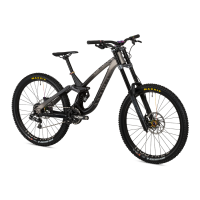MAINTENANCE & PERIODICAL SAFETY CHECKS
DO NOT RIDE THE BICYCLE IF IT YOU SEE ANY DEFECTS.
Take care of your frame and you will enjoy it for a longer time. Before every ride you should always make a pre-ride check. It
should include the following points: clean the frame (note that high-pressure washing may cause damage to some compo-
nents on the bicycle so it should be avoided if possible) and examine it CAREFULLY for any indications of potential failures
including cracks, corrosion, dents, paint peeling and any other indications of potential problems, inappropriate use or abuse.
If anything suspicious is found, contact your local bike dealer for a proper inspection. These are important safety checks and
very important to help prevent accidents, injury and shortened product lifespan.
Things to check before each ride:
- all frame bolts are correctly tightened – refer to # TIGHTENING TORQUE
- wheel to frame & fork connections - this is critical for your safety. If you have axle bolts they should be tightened according
to the manufacturer’s specification. If you have a quick release make sure that it is set to the CLOSED position, and that there
is a reasonable amount of resistance applied.
- steering system. The steering system includes: handle bar, stem, headset and fork. All elements should be connected firmly
for riding safety. If you wish to make any adjustments yourself, be warned that incorrect setup can be very dangerous and we
always advise you to seek professional advice for this! Check headset looseness, check stem to handlebar connection and
stem to steertube connection. Check the connection between the handlebars and stem. Try pushing the handlebars up and
down - there should be no movement between these two elements. Check the headset for eventual free play (stand next to
the bicycle, apply the front brake and push forwards and backwards. There should be no play between the frame and fork).
If any play is found contact your local bike shop. Do not attempt to make any adjustments yourself. If you are confident that
you can do this yourself then adjust the steering system according to the headset/stem manufacturer instructions. All parts
of the stem should be regularly checked for damage or cracks. If you find anything suspicious, contact an experienced bike
mechanic immediately. A defective steering system can cause serious injury or death.
- bottom bracket connection to the frame. There should be no play between the frame and bottom bracket.
- the connection between the cranks and bottom bracket.
- the connection of the pedals to the cranks.
- chain line and chain tension.
- derailleur connection with the frame and make sure the function is proper before every ride.
- brake clamp to frame & fork connection.
- the general condition of rear shock and front fork (take special note of any cracks or deformations).
- shock / fork pressure (for air shocks). Refer to the # SUSPENSION SETTINGS and manufacturers instruction. Make sure
the SAG doesn’t exceed the reasonable limit. Make sure the air pressure does not exceed limits provided by shock / fork
manufacturer
- clean rear shock & forks stanchion tubes.
- brake cables and their housing for kinks, rust, broken strands or frayed ends. If you notice any damage, you should ask a
bicycle shop to replace the cables immediately. Damaged cables can seriously impede braking eciency.
For information about servicing the shock and other parts like the headset mounted on the bike it is necessary to follow
manufacturers instructions closely. The user manual for the additional parts are supplied in the frame box.
16
FUZZ

